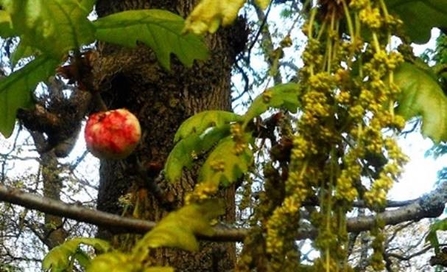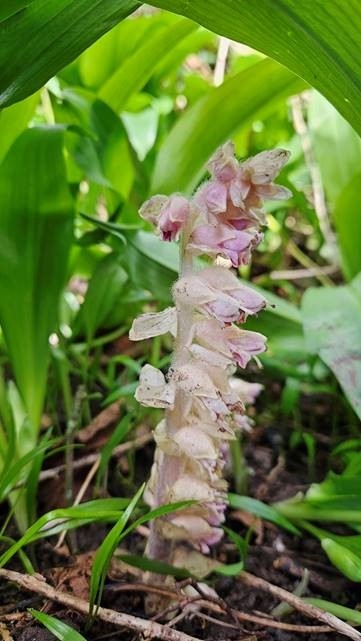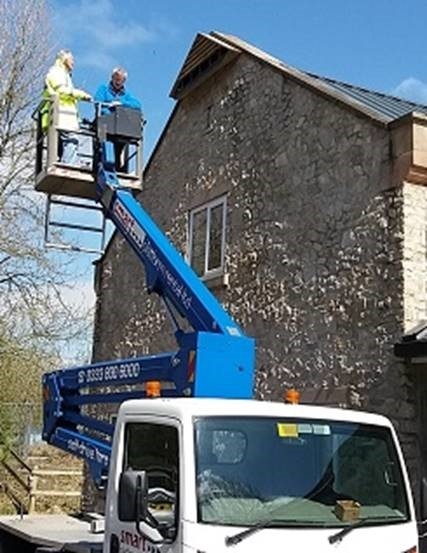Spring into Summer
From a wildlife perspective, late April and early May is a time of feverish activity; migrant birds are returning, our resident species are nesting, plants are growing fast and insects are appearing once more.
There’s much to discover and enjoy so it’s important to make the most of it!
The mighty oak
As oak trees come into leaf, their colours start bronze and then go through a range of yellowy greens before eventually become a rather ‘dull green’ by June. For me, they are one of the delights of this special time of the year.
Wild Update - Late April 2024

Bronze oak leaves, 25 April 2024 - NB
Meanwhile, oak flowers, being wind pollinated, are insignificant and easily missed.
Not so the oak apple galls which also appear now. I’ve seen three so far, all a striking pink or red colour. Read about what causes them: Oak apple gall wasp | The Wildlife Trusts .

An oak apple caused by a tiny asp and oak flowers (right). 20/04/2024 - NB
Dental lookalikes
Toothwort is a very strange and quite rare plant that flowers in late April and May.
It is parasitic on the roots of trees such as hazel, alder and elm, completely lacking any chlorophyll and getting all its sustenance from its host.
The flowers look somewhat toothlike being whitish though sometimes tinged with pink or violet.
Toothwort can be seen growing at Rose End Meadows Reserve at Cromford. See its county distribution:
Flora of Derbyshire - Lathraea squamaria (Toothwort) (kevinhutchby.uk)

Toothwort - Amy Bennet
Return of the swifts
Last Sunday saw an influx of swifts back to the UK with the first bird seen in Derbyshire a couple of days later.
The main arrival won’t take place until May. By August, most will already have left our shores and be heading back to the Congo forests over which they will fly during most of our winter.
The attachment provides a quick and easy introduction to the species and this cheery video is also well worth a look:https://www.youtube.com/watch?v=W8NuL5mEpjo
Having declined by over 60% in the last 25 years, swifts are in deep trouble. They nest inside our buildings, accessing internal spaces under tiles or more often behind the tops of walls using tiny gaps in the mortar to enter.
When we renovate older buildings we inadvertently block these holes up denying the birds access. This is the major cause of the swift’s decline.
There are two simple and cheap things that can be done to help: External nest boxes can be sited on existing housing whereas on new buildings and internal ‘swift bricks’ can be installed in walls as they are being built.
It’s easy and cheap – a no-brainer - but getting councils to condition them and developers to install them is a different matter!

A swift brick s easy to install as new walls are being built
In 2014 I started an informal, unfunded project trying to raise the profile of these birds. With the recent addition of some new blood, a new organisation, Derbyshire Swift Conservation has just been established with its own bank account, website and trustees (of which I am one): Home - Derbyshire Swift Conservation Project .
Currently, a bid to the lottery is underway to take swift conservation forward in Derbyshire Dales, a joint project with the district council.
How you could help swifts this summer
- If you know where swifts nest or see them screaming above rooftops please send a record to DBRC, DSC or to me.
- If you are interested in helping with any survey work please get in touch. Special focus will be on the Derbyshire Dales area and
on Belper.
- You could put some swift boxes on your house. I can advise on suppliers etc.

Cherry picker used to install the swift box at DWT HQ - NB
Open the hatch!
The Derby Cathedral peregrine eggs look likely to hatch within the next 24 - 48 hours.
It’s well worth keeping an eye on the blog comments and web cams over the weekend: www.bit.ly/derbyblog or search for ‘Derby peregrines’.



